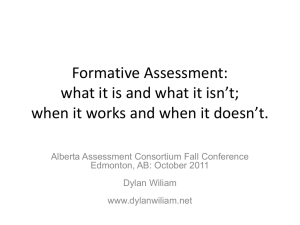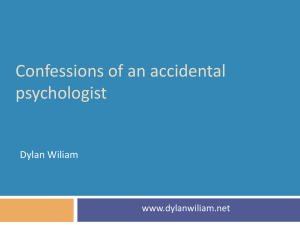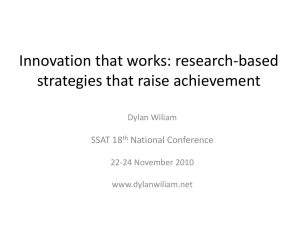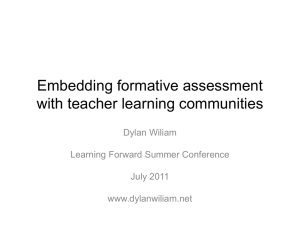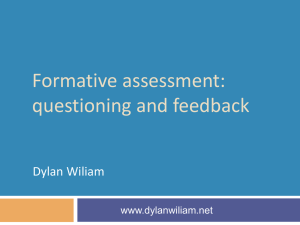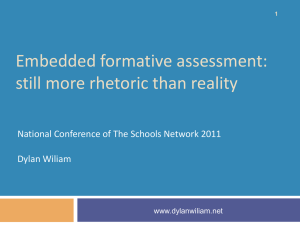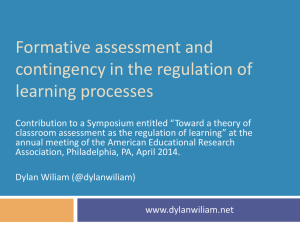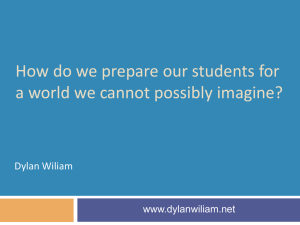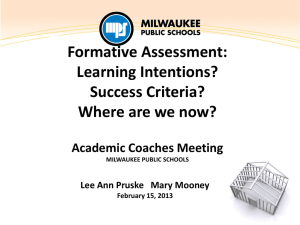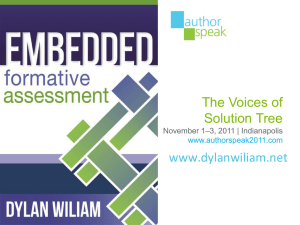The bridge between teaching and learning
advertisement
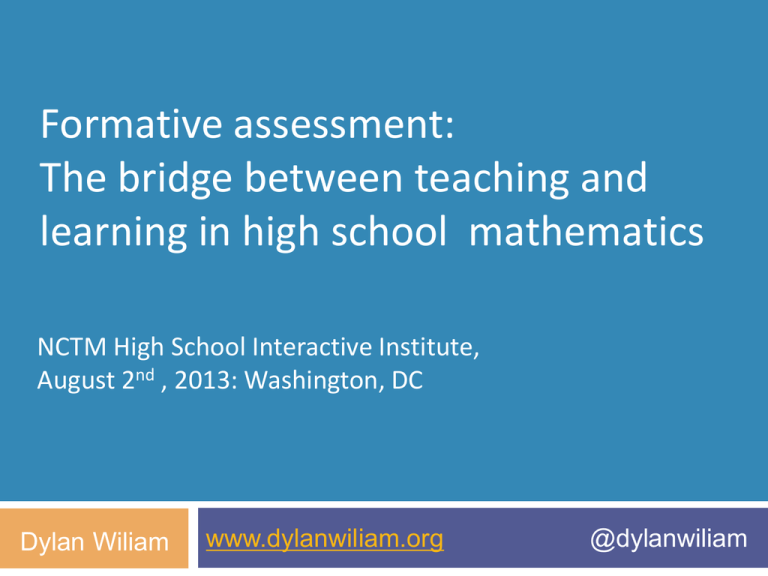
Formative assessment: The bridge between teaching and learning in high school mathematics NCTM High School Interactive Institute, August 2nd , 2013: Washington, DC Dylan Wiliam www.dylanwiliam.org @dylanwiliam The evidence base for formative assessment 2 Fuchs & Fuchs (1986) Natriello (1987) Crooks (1988) Bangert-Drowns, et al. (1991) Dempster (1991, 1992) Elshout-Mohr (1994) Kluger & DeNisi (1996) Black & Wiliam (1998) Nyquist (2003) Brookhart (2004) Allal & Lopez (2005) Köller (2005) Brookhart (2007) Wiliam (2007) Hattie & Timperley (2007) Shute (2008) Cost/effect comparisons Extra months of learning per year Cost/class-room/yr Class-size reduction (by 30%) 4 $30k Increase teacher content knowledge from weak to strong 2 ? Formative assessment/ Assessment for learning 8 $3k Intervention The formative assessment hijack Long-cycle: Span: across units, terms Length: four weeks to one year Impact: Student monitoring; curriculum alignment Medium-cycle: Span: within and between teaching units Length: one to four weeks Impact: Improved, student-involved assessment; teacher cognition about learning Short-cycle: Span: within and between lessons Length: day-by-day: 24 to 48 hours minute-by-minute: five seconds to two hours Impact: classroom practice; student engagement Unpacking formative assessment 5 Where the learner is going Teacher Peer Learner Clarifying, sharing and understanding learning intentions Where the learner is How to get there Providing Engineering effective discussions, tasks, and feedback that moves learners activities that elicit forward evidence of learning Activating students as learning resources for one another Activating students as owners of their own learning And one big idea 6 Where the learner is going Teacher Peer Learner Where the learner is How to get there Using evidence of achievement to adapt what happens in classrooms to meet learner needs An educational positioning system A good teacher: Establishes where the students are in their learning Identifies the learning destination Carefully plans a route Begins the learning journey Makes regular checks on progress on the way Makes adjustments to the course as conditions dictate Strategies and practical techniques for classroom formative assessment 8 Clarifying, sharing and understanding learning intentions 9 A standard middle school math problem… Two farmer have adjoining fields with a common boundary that is not straight. This is inconvenient for ploughing. How can they divide the two fields so that the boundary is straight, but the two fields have the same area as they had before? How many rectangles? m ( m -1) n ( n -1) ´ 2 2 Share learning intentions 14 Explain learning intentions at start of lesson/unit: Learning intentions Success criteria Consider providing learning intentions and success criteria in students’ language Use posters of key words to talk about learning: E.g., describe, explain, evaluate Use planning and writing frames judiciously Use annotated examples of different standards to “flesh out” assessment rubrics (e.g., lab reports). Provide opportunities for students to design their own tests. Engineering effective discussions, activities, and classroom tasks that elicit evidence of learning 15 Kinds of questions: Israel Which fraction is the smallest? 1 2 1 1 a) , b) , c) , d) . 6 3 3 2 Success rate 88% Which fraction is the largest? 4 3 5 7 a) , b) , c) , d) . 5 4 8 10 Success rate 46%; 39% chose (b) Vinner (1997) Eliciting evidence Key idea: questioning should cause thinking provide data that informs teaching Improving teacher questioning generating questions with colleagues low-order vs. high-order not closed vs. open appropriate wait-time Getting away from I-R-E basketball rather than serial table-tennis ‘No hands up’ (except to ask a question) ‘Hot Seat’ questioning All-student response systems ABCD cards, “show-me” boards, exit passes A closed question in calculus… 18 So, is the derivative of x2 approximately, or exactly, 2x? Kinds of questions 19 Questioning in math: Discussion Look at the following sequence: 3, 7, 11, 15, 19, …. Which is the best rule to describe the sequence? A. n + 4 B. 3 + n C. 4n - 1 D. 4n + 3 Questioning in math: Diagnosis In which of these right triangles is a2 + b2 = c2 ? A b a B a c C b a b D c c b c E c a a b F b c a Hinge questions A hinge question is based on the important concept in a lesson that is critical for students to understand before you move on in the lesson. The question should fall about midway during the lesson. Every student must respond to the question within two minutes. You must be able to collect and interpret the responses from all students in 30 seconds Real-time test: equations 23 Solve the following equations 1. 2. 3. 4. 5. 6. 3x + 3 = 12 5x – 1 = 19 12 – 2x = 3 4 = 31 – 3x 4x – 3 = 2x + 5 3 – 2x = 4 – 4x Constructing hinge-point questions Discriminate incorrect cognitive rules Version 1 (Hart, 1981) Version 2 If e+f = 8, then e+f+g = If f+g = 8, then f+g+h = a. b. c. d. 9 12 15 8+g a. b. c. d. e. 9 12 15 16 8+h Diagnostic item: medians What is the median for the following data set? 38 a. b. c. d. e. f. g. 74 22 44 96 22 22 38 and 44 41 46 70 77 This data set has no median 19 53 Diagnostic item: means What can you say about the means of the following two data sets? Set 1: Set 2: 10 10 12 12 13 13 15 15 0 A. The two sets have the same mean. B. The two sets have different means. C. It depends on whether you choose to count the zero. Providing feedback that moves learners forward Kinds of feedback: Israel 264 low and high ability grade 6 students in 12 classes in 4 schools; analysis of 132 students at top and bottom of each class Same teaching, same aims, same teachers, same classwork Three kinds of feedback: scores, comments, scores+comments Scores Comments Butler(1988) Achievement Attitude no gain High scorers : positive Low scorers: negative 30% gain High scorers : positive Low scorers : positive Responses 30 Scores Comments Achievement Attitude no gain High scorers : positive Low scorers: negative 30% gain High scorers : positive Low scorers : positive What happened for the students given both scores and comments? A. Gain: 30%; Attitude: all positive B. Gain: 30%; Attitude: high scorers positive, low scorers negative C. Gain: 0%; Attitude: all positive D. Gain: 0%; Attitude: high scorers positive, low scorers negative E. Something else Kinds of feedback: Israel (2) 200 grade 5 and 6 Israeli students Divergent thinking tasks 4 matched groups experimental group 1 (EG1); comments experimental group 2 (EG2); grades experimental group 3 (EG3); praise control group (CG); no feedback Achievement EG1>(EG2≈EG3≈CG) Ego-involvement (EG2≈EG3)>(EG1≈CG) Butler (1987) Effects of feedback Kluger & DeNisi (1996) review of 3000 research reports Excluding those: without adequate controls with poor design with fewer than 10 participants where performance was not measured without details of effect sizes left 131 reports, 607 effect sizes, involving 12652 individuals On average, feedback increases achievement Effect sizes highly variable 38% (50 out of 131) of effect sizes were negative Getting feedback right is hard Response type Feedback indicates performance… falls short of goal exceeds goal Change behavior Increase effort Exert less effort Change goal Reduce aspiration Increase aspiration Abandon goal Decide goal is too hard Decide goal is too easy Reject feedback Feedback is ignored Feedback is ignored Provide feedback that moves learning on Key idea: feedback should: Cause thinking Provide guidance on how to improve Comment-only grading Focused grading Explicit reference to mark-schemes/rubrics Suggestions on how to improve: Not giving complete solutions Re-timing assessment: E.g., three-fourths-of-the-way-through-a-unit test Activating students as learning resources for one another 35 Collaborative learning: a research success story Four mechanisms Motivation: students help their peers to learn because, in well-structured cooperative learning settings, it is in their own interests to do so, and so effort is increased; Social cohesion: students help their peers because they care about the group, again leading to increased effort; Personalization: students learn more because more able peers can engage with the particular difficulties a student is having; Cognitive elaboration: those who provide help in group settings are forced to think through the ideas more clearly. Help students be learning resources Students assessing their peers’ work: “Pre-flight checklist” “Two stars and a wish” Choose-swap-choose Daily sign-in Training students to pose questions/identifying group weaknesses End-of-lesson students’ review Activating students as owners of their own learning 38 Help students own their own learning Students assessing their own work: With rubrics With exemplars Self-assessment of understanding: Learning portfolio Traffic lights Red/green discs Colored cups Plus/minus/interesting A model for teacher learning 40 Content, then process Content (what we want teachers to change): Evidence (formative assessment) Ideas (strategies and techniques) Process (how to go about change): Choice Flexibility Small steps Accountability Support Questions? Comments? 41
